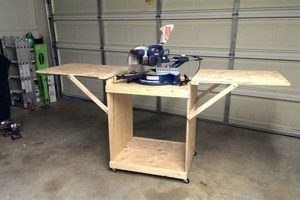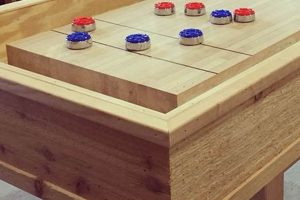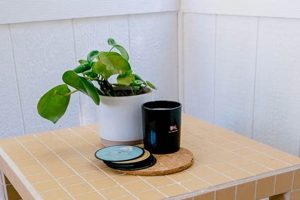Construction of personalized surfaces designed for tabletop games is a growing trend among hobbyists. These custom-built structures offer tailored dimensions, features, and aesthetics to enhance the gaming experience. For instance, a dedicated player might build a surface with recessed areas for dice rolling, integrated cupholders, or a removable topper to convert the playing area into a regular table when not in use.
The creation of such furniture provides several advantages. It allows for cost savings compared to purchasing commercially available options, which can be prohibitively expensive. Furthermore, it enables individuals to precisely match the table’s size and style to their specific needs and available space. Historically, dedicated gaming spaces were often the domain of affluent individuals or established institutions; however, accessibility to information and readily available materials has democratized the process, allowing anyone with basic carpentry skills to create their own personalized gaming environment.
This accessibility leads to exploration of available resources, material selection considerations, design planning principles, and step-by-step construction methodologies. Further discussion will cover these aspects in greater detail, providing a framework for successful project completion.
Tips for Constructing a Customized Gaming Surface
Successful creation of a personalized gaming area requires meticulous planning and execution. The following guidelines offer essential advice for optimal results throughout the project lifecycle.
Tip 1: Precise Measurement is Paramount. Begin by accurately measuring the intended playing area and available space. Consider the number of players typically involved and the size of game components to ensure adequate surface area. Document all measurements meticulously.
Tip 2: Prioritize Material Selection. Opt for durable, stable materials suitable for the intended use. Solid hardwoods, such as oak or maple, offer superior strength and longevity, but may require greater investment. Plywood or MDF (Medium-Density Fiberboard) provide more cost-effective alternatives, but require careful sealing and finishing.
Tip 3: Develop a Detailed Design Plan. Create a comprehensive blueprint outlining all dimensions, features, and construction methods. Include detailed diagrams of joints, reinforcements, and any specialized elements, such as recessed areas or cupholders. This plan serves as a critical reference throughout the building process.
Tip 4: Employ Secure Joinery Techniques. Utilize robust joinery methods to ensure structural integrity. Options include mortise and tenon joints, dovetail joints, or pocket hole joinery, depending on the skill level and desired aesthetic. Proper glue application and clamping are essential for strong, lasting connections.
Tip 5: Implement a Level Playing Surface. Achieving a perfectly level playing surface is crucial for fair gameplay. Use a level to check the surface at multiple points and make necessary adjustments during construction. Consider incorporating adjustable feet to compensate for uneven flooring.
Tip 6: Carefully Consider Finish Application. Apply a durable finish to protect the surface from scratches, spills, and wear. Options include polyurethane, varnish, or epoxy resin, each offering different levels of protection and aesthetic qualities. Proper surface preparation, including sanding and priming, is essential for optimal finish adhesion and appearance.
Tip 7: Integrate Cable Management Solutions. For games involving electronic components, incorporate cable management solutions to prevent clutter and ensure safe operation. This may involve drilling access holes, installing cable trays, or using Velcro straps to secure wires and power cords.
Adhering to these guidelines will significantly improve the likelihood of constructing a robust, functional, and aesthetically pleasing gaming area. Thoughtful planning and careful execution are key to creating a valuable addition to any gaming enthusiast’s home.
Following these recommendations, the next phase of the article will explore specific construction techniques and available resources to aid in building a customized gaming surface.
1. Dimensions and Scale
The dimensions and scale are fundamental considerations in personalized gaming area construction. These parameters directly influence the functionality, user experience, and spatial integration of the finished product. Appropriate sizing ensures adequate playing space, while proportional scale contributes to visual harmony and ergonomic comfort.
- Game Type Accommodation
Different tabletop games necessitate varying surface areas. Miniature wargames, such as Warhammer 40,000, require expansive landscapes for movement and deployment. Conversely, card games like Magic: The Gathering can be played comfortably on a smaller footprint. Table dimensions must therefore align with the anticipated game types to ensure adequate maneuverability and component placement.
- Player Count Considerations
The number of players influences the necessary table circumference. Insufficient space results in overcrowding and restricted player interaction. Conversely, an excessively large table can create social distance and impede communication. Careful calculation of the per-player surface area is crucial for fostering an optimal gaming experience.
- Spatial Constraints and Integration
The dimensions of the intended gaming area must align with the available space within the room. Overly large constructions may dominate the environment and impede circulation. Consideration should be given to room dimensions, existing furniture, and potential obstructions, such as doorways or windows. Scaled designs ensure seamless integration with the surrounding environment.
- Component Storage and Accessibility
Integrating storage solutions within the structure can enhance functionality and organization. Recessed compartments, drawers, or shelves can accommodate game components, such as cards, dice, and miniatures. The size and placement of these storage elements must be carefully considered to ensure accessibility and prevent interference with the playing surface. Integrated storage contributes to a more streamlined and enjoyable gaming experience.
In conclusion, a careful evaluation of dimensions and scale is paramount in the design process. Factors such as game type, player count, spatial constraints, and storage requirements must be considered to optimize the functionality, user experience, and spatial integration of the completed construction. Failure to address these aspects can result in an inadequate or visually discordant gaming surface.
2. Material Durability
In the context of personalized gaming surface construction, material durability is a critical determinant of the project’s longevity and overall success. The selected materials must withstand the rigors of regular use, including impacts from dice rolls, the friction of game components, and potential spills. Consequently, the choice of materials directly affects the long-term maintenance requirements and the frequency of necessary repairs or replacements. Failure to prioritize durability results in a surface prone to damage, detracting from the gaming experience and necessitating premature reconstruction.
The interplay between material selection and structural design significantly influences the overall durability of the constructed surface. A robust frame constructed from hardwoods, for example, provides a stable foundation capable of supporting substantial weight and resisting warping. Conversely, a frame constructed from lower-grade materials, such as particleboard, is susceptible to deformation and failure under stress. Similarly, the choice of surface material dictates its resistance to scratches, stains, and moisture damage. A laminate surface, while cost-effective, is less resistant to damage than a solid wood or epoxy resin finish. Therefore, careful consideration of both structural components and surface finishes is paramount to maximizing the lifespan of the finished product.
In summary, material durability is an indispensable consideration in personalized gaming environment construction. Strategic material choices and sound structural design contribute to a long-lasting, functional, and aesthetically pleasing gaming surface. Neglecting this aspect increases the risk of damage, necessitates frequent repairs, and ultimately diminishes the value and enjoyment derived from the construction. Future discussions will address other critical design elements contributing to a successful personalized gaming area.
3. Structural Integrity
Structural integrity is a non-negotiable attribute in the realm of customized gaming surfaces. A lack of sound construction principles precipitates instability, resulting in a playing surface prone to wobbling, sagging, or even catastrophic failure. This negatively impacts gameplay, jeopardizes the safety of users, and undermines the overall investment in materials and labor. A structurally deficient surface compromises the precise movement of game pieces and the consistent rolling of dice, thereby invalidating the integrity of the gaming experience. Consider, for example, a large-scale miniature wargaming surface constructed with insufficient support; the weight of terrain features and miniatures could cause the tabletop to bow, rendering sections of the playing field unusable. The cause-and-effect relationship is straightforward: inadequate structural design leads to functional impairment and premature deterioration.
The significance of structural integrity extends beyond mere stability; it influences the permissible load capacity and the potential for long-term durability. Reinforced joints, properly sized support beams, and appropriate material selection are paramount in ensuring that the gaming surface can withstand the stresses associated with regular use. For example, a gaming surface intended for use with heavy board games or complex terrain systems necessitates a robust internal framework capable of distributing weight evenly. Ignoring this principle can lead to localized stress points and eventual structural compromise. Furthermore, consideration must be given to the dynamic loads imposed during gameplay, such as leaning or accidental impacts. Solid wood construction, incorporating proven joinery techniques, represents a standard approach to achieving the necessary structural resilience, particularly for larger surfaces.
In summary, structural integrity constitutes a foundational element in the successful creation of a customized gaming environment. Its absence results in diminished functionality, compromised safety, and reduced longevity. Proper design, material selection, and construction techniques are essential for ensuring that the finished product meets the demands of its intended use. This understanding is not merely theoretical; it translates directly into practical benefits, including enhanced gameplay, increased user safety, and a more sustainable investment in the gaming hobby.
4. Surface Finish
In the context of personalized gaming surface construction, the surface finish represents a critical determinant of both aesthetic appeal and functional performance. The selection and application of an appropriate finish directly impact the durability, cleanability, and overall usability of the gaming area. A poorly chosen or improperly applied finish compromises the playing experience and accelerates wear, necessitating premature refurbishment. For instance, a raw wood surface, lacking any protective coating, is highly susceptible to staining from spills, scratches from game components, and moisture damage leading to warping. This necessitates a finish that provides a durable barrier against such common occurrences.
Specific applications underscore the practical significance of careful finish selection. Surfaces intended for miniature wargaming, involving the frequent movement of painted miniatures, require a robust, scratch-resistant finish, such as polyurethane or epoxy resin. These finishes provide a hard, durable layer that protects the underlying wood from damage and allows for easy cleaning of spilled paint or glue. Conversely, surfaces designed primarily for card games may benefit from a smoother, less reflective finish to reduce glare and enhance visibility. In all instances, the finish must be compatible with the underlying material to ensure proper adhesion and prevent premature peeling or cracking. This requires thorough research and testing to confirm compatibility.
In summary, the surface finish is an integral component of any successful custom gaming surface construction. Its selection must be guided by a thorough understanding of the intended use, material properties, and desired aesthetic. A well-chosen and properly applied finish enhances the gaming experience, extends the lifespan of the surface, and ultimately represents a valuable investment in the longevity and enjoyment of the hobby. Neglecting this aspect compromises the functional and aesthetic qualities of the finished product, leading to diminished satisfaction and increased maintenance requirements.
5. Ergonomic Design
In the context of constructing personalized gaming areas, ergonomic design principles are crucial for ensuring player comfort, minimizing physical strain, and promoting prolonged engagement with tabletop games. The application of ergonomics extends beyond mere comfort, encompassing factors that influence posture, reach, and visual acuity.
- Optimal Table Height
Table height directly impacts posture and reduces strain on the back, neck, and shoulders. The ideal height allows players to rest their forearms comfortably on the table surface while maintaining an upright posture. A table that is too low forces players to hunch over, while one that is too high causes them to elevate their shoulders. Determining the average seated height of intended users and adjusting the design accordingly is essential. For standing play, the table height should allow the elbows to be bent at a 90-degree angle while comfortably reaching the playing surface.
- Reach and Accessibility
The dimensions of the playing surface must be carefully considered to ensure that all areas are easily accessible to all players. Excessive table depth can force players to strain or reach uncomfortably to manipulate game components. Conversely, insufficient space restricts movement and hinders gameplay. Designing a table with a comfortable reach radius, typically within arm’s length, minimizes strain and enhances the gaming experience. Incorporating curved edges or modular designs can further improve accessibility.
- Integrated Support Features
Integrating features that promote comfort and reduce strain can significantly enhance the ergonomic design. Examples include padded armrests to reduce pressure on the forearms and wrists, adjustable leg supports to accommodate varying player heights, and built-in cupholders to prevent spills and reduce the need to reach for beverages. These features contribute to a more relaxed and enjoyable gaming session.
- Visual Considerations
Ergonomic design also encompasses visual comfort and clarity. The playing surface should be finished with a non-glare material to minimize eye strain. Adequate lighting, both ambient and task-specific, is essential for clear visibility of game components. Incorporating adjustable lighting fixtures allows players to customize the illumination to suit their preferences and the specific game being played. Proper visual design reduces fatigue and enhances focus.
In conclusion, incorporating ergonomic design principles into personalized gaming area construction is essential for promoting player comfort, reducing physical strain, and enhancing the overall gaming experience. By carefully considering factors such as table height, reach accessibility, integrated support features, and visual comfort, creators can build gaming surfaces that are not only functional and aesthetically pleasing but also conducive to prolonged and enjoyable gameplay.
6. Aesthetic Integration
Aesthetic integration, in the context of constructing personalized gaming environments, refers to the seamless harmonization of the gaming surface with the existing decor and architectural style of the surrounding space. Successful integration transcends mere visual appeal; it involves aligning the table’s design, materials, and finishes with the existing aesthetic to create a cohesive and visually pleasing environment. Failure to consider aesthetic integration results in a discordant element that detracts from the overall ambiance of the room. For instance, a modern, minimalist gaming table constructed from steel and glass would appear incongruous within a traditionally styled study featuring dark wood furniture and ornate details.
The importance of aesthetic integration stems from its impact on the overall user experience and the perceived value of the constructed surface. A gaming table that complements the existing decor enhances the sense of immersion and creates a more inviting and enjoyable gaming environment. Conversely, a visually jarring element can distract players and undermine the feeling of escapism that tabletop gaming often provides. Furthermore, a well-integrated surface increases the perceived value of the investment, transforming it from a functional object into a complementary piece of furniture that enhances the aesthetic of the room. Consider, for example, a gaming table designed to mimic a historical map within a room decorated with antique globes and navigational instruments; the cohesive design elevates the gaming experience and enhances the perceived value of the surface.
In summary, aesthetic integration is a crucial consideration in personalized gaming area construction. Aligning the gaming surface with the existing decor enhances the user experience, increases the perceived value of the investment, and transforms the surface from a mere functional object into a complementary piece of furniture. Challenges in achieving seamless integration include accurately assessing the existing aesthetic, selecting appropriate materials and finishes, and executing the design with precision. Successfully navigating these challenges results in a gaming environment that is both functional and visually harmonious, contributing to a more immersive and enjoyable gaming experience.
Frequently Asked Questions
This section addresses common inquiries and misconceptions pertaining to the design, construction, and maintenance of customized gaming tables. The information presented aims to provide clarity and guidance for individuals considering such a project.
Question 1: What is the typical cost associated with creating a personalized gaming surface?
The cost varies significantly depending on the size, materials, and complexity of the design. Projects utilizing readily available materials such as plywood and basic hardware may range from $200 to $500. However, constructions employing premium hardwoods, integrated electronics, and custom-fabricated components can easily exceed $1,000. A detailed budget outlining all anticipated expenses is essential prior to commencing construction.
Question 2: What tools and skills are necessary for successful construction?
Basic carpentry skills are generally required, including proficiency in measuring, cutting, joining, and finishing wood. Essential tools include a circular saw, jigsaw, drill/driver, sander, and various hand tools. More complex designs may necessitate specialized equipment, such as a router or table saw. Prior experience with woodworking projects is highly recommended.
Question 3: How does one ensure the playing surface is perfectly level?
Achieving a level surface requires careful measurement and adjustment throughout the construction process. A high-quality level should be used to check the surface at multiple points. Shims or adjustable feet can be employed to compensate for minor discrepancies. Self-leveling epoxy resin can also be applied to create a perfectly flat surface, though this requires precise application techniques.
Question 4: What is the best type of finish to protect the surface from spills and scratches?
Durable finishes such as polyurethane, varnish, or epoxy resin offer excellent protection against spills and scratches. Polyurethane provides a hard, abrasion-resistant surface. Varnish offers a more traditional look and feel. Epoxy resin creates a thick, glossy surface that is highly resistant to damage. The choice depends on the desired aesthetic and the level of protection required.
Question 5: How can electronic components be integrated safely and effectively?
Safe integration of electronic components requires careful planning and adherence to electrical safety standards. Wires should be properly insulated and secured to prevent shorts or hazards. Power supplies should be appropriately sized and protected with fuses. Access holes and cable management solutions should be incorporated into the design to maintain a clean and organized appearance. Consulting with a qualified electrician is recommended for complex electrical installations.
Question 6: What are the key considerations for designing a surface for a specific game?
The design should accommodate the specific components and gameplay mechanics of the intended game. The size of the playing area should be sufficient to accommodate all cards, miniatures, or other game pieces. Recessed areas for dice rolling or card placement can enhance organization and prevent components from sliding off the table. Consider incorporating integrated storage solutions for game components and accessories.
In summary, careful planning, meticulous execution, and adherence to sound construction principles are essential for the successful creation of a personalized gaming surface. The information provided in this FAQ addresses common concerns and provides guidance for individuals embarking on such a project.
The subsequent section explores available resources and support networks for those seeking further assistance or inspiration.
Conclusion
The preceding discussion has systematically explored the critical elements involved in crafting personalized gaming environments. From foundational design considerations, such as dimensions, material selection, and structural integrity, to the nuanced aspects of surface finish, ergonomic integration, and aesthetic harmonization, each component plays a crucial role in determining the final product’s utility and longevity. This article provides insight into aspects of constructing customized gaming areas with a focused approach to practical challenges and design requirements.
The construction of custom surfaces represents a significant undertaking that demands careful planning and diligent execution. It is incumbent upon those undertaking such projects to meticulously consider the information presented, adapt the knowledge to their specific needs and constraints, and prioritize safety and structural soundness. Continued refinement of construction techniques and exploration of innovative materials will undoubtedly lead to further advancements in the field, enhancing the gaming experience for enthusiasts worldwide. Further dedicated research and meticulous planning remain crucial for achieving a satisfying gaming environment construction that lasts.







